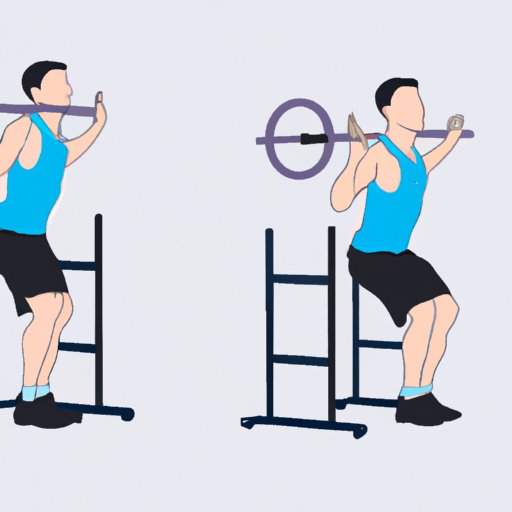
I. Introduction
Are you looking to tone your lower body while enhancing your overall strength and stability? Look no further than squats! This powerful exercise works multiple muscle groups while improving balance and joint flexibility.
However, many individuals struggle with proper form and technique when attempting squats, leading to potential injury or ineffective workouts. In this guide, we break down the steps necessary to master squats and maximize their benefits.
II. Mastering the Squat: A Step-by-Step Guide for Beginners
Squats can be broken down into a few simple steps:
- Stand with feet hip-width apart and toes facing forward.
- Engage your core and lower your body as if sitting back into a chair.
- Keep your knees in line with your toes and your weight over your heels.
- Push through your heels to return to standing position.
It is important to maintain proper form and technique while performing each step. Start with bodyweight squats before introducing weights.
Visual aids such as YouTube tutorials or personal training sessions can also help you perfect your form.
III. Tips and Tricks for Perfecting Your Squat Form
Here are some common mistakes to avoid while squatting:
- Allowing your knees to collapse inward
- Rocking forward onto your toes
- Arching your back or leaning too far forward
To correct these mistakes, focus on keeping your weight over your heels, engaging your core, and keeping your knees aligned with your toes.
Consistently practicing proper form and technique will increase the effectiveness of your squats and reduce your risk of injury.
IV. Squatting 101: The Benefits and Proper Technique
The benefits of incorporating squats into your fitness routine are numerous. Not only do they tone and strengthen your legs, but they also improve joint flexibility, boost metabolism, and enhance athletic performance.
The proper technique for squatting involves keeping your chest lifted, hips pushed back, and core engaged. It is important to gradually increase the weight and intensity of your squats to avoid injury.
Note: Always consult a physician before starting a new fitness regimen.

V. How to Avoid Common Mistakes When Squatting
Some common mistakes while squatting include:
- Not warming up properly before squats
- Using improper footwear or equipment
- Performing squats with incorrect form
To avoid these mistakes, always warm up before squatting, wear the proper shoes and equipment, and focus on maintaining correct form throughout the exercise.
VI. The Science Behind the Squat: Muscles Worked and Benefits
Squats work multiple muscle groups, including the quadriceps, hamstrings, glutes, calves, and core. This exercise also improves joint mobility and flexibility, while increasing muscle mass and overall strength.
By engaging in regular squatting, you can reduce your risk of injury, boost your metabolic rate, and enhance your athletic performance.
Additionally, incorporating variations such as sumo squats or barbell squats can further work these muscle groups and increase the intensity of your workouts.
VII. Maximizing Your Leg Day Workout with Effective Squatting
Leg day can be a challenging workout, but squats can make it a rewarding experience.
By incorporating various types of squats into your routine, such as jump squats or goblet squats, you can further target certain muscle groups. It is important to always maintain proper form and technique, and to gradually increase weights and repetitions to avoid injury.
VIII. Progressing to Advanced Squat Variations Safely and Efficiently
Once you have mastered basic squats, you can move onto advanced variations such as pistol squats or front squats. However, it is important to progress slowly and safely, gradually increasing weights and repetitions.
Additionally, incorporating core-strengthening exercises such as planks or Russian twists can further enhance your squatting abilities.
Remember, maintaining proper form and technique is crucial to preventing injury.
IX. Conclusion
Squats are an ideal exercise for toning your legs while improving your overall strength and mobility. By following these tips and tricks for proper form and technique, you can maximize their benefits and avoid injury.
Remember to always consult a physician before beginning a new fitness routine, and to gradually increase weight and intensity to prevent injury.





